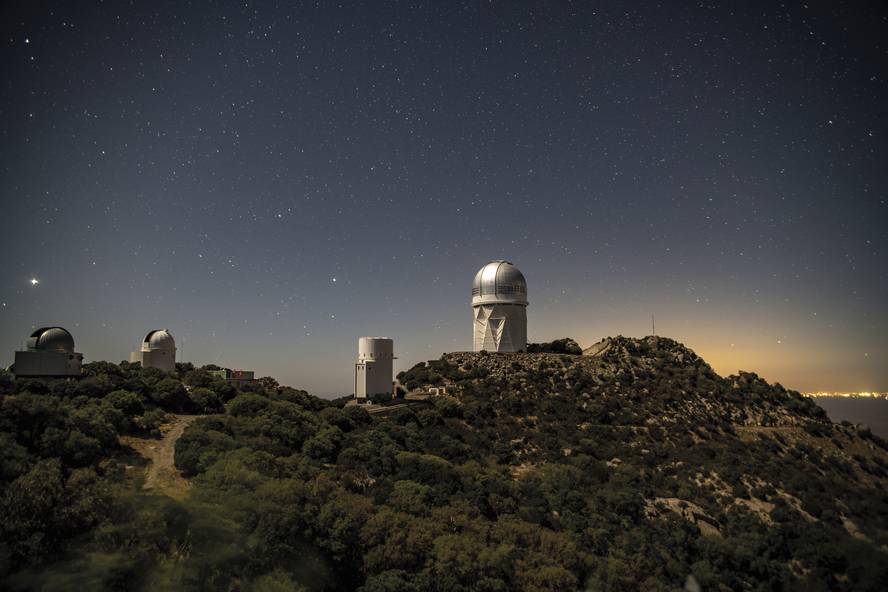A window to light up dark energy
According to the most accepted model, it forms two-thirds of the universe; but we don't know what it is. We call it dark energy. And to know what that energy is or what it is, great experiments are underway. The first results of one of them occurred in the spring, and their interpretation has raised controversy by suggesting that what was supposedly needed a constant can be variable.

“For the time being, data generally matches the best model in the universe so far, but there are also some interesting differences that suggest that dark energy can be variable, evolves.” This is how the first results of this experiment were presented last April by the cooperation director DESI, Michael Levi.
Although this interpretation has raised controversy among cosmologists, no one doubts the value of the results obtained by the DESI. This is the largest experiment carried out for the research of the cosmos. And they've presented a map of the unprecedented universe: a three-dimensional map of six million galaxies and 450,000 quasars that shows how the distribution of matter has been in eleven billion years. All this to try to understand what dark energy is, for which they designed the Dark Energy Spectroscopic A3 DESI.
“In the best example of the universe we have, 95% of the universe we don’t know anything,” says Violeta González Pérez. González is a theoretical physicist from the Autonomous University of Madrid and one of the 900 scientists who collaborate in the DESI. “That is, taking into account all the matter and energy of the universe, 95% corresponds to a dark part that we don’t understand. So cosmology is important. As human beings, we need to understand what the universe is made of.”

In fact, common matter, what we can see, what we know, is no more than 5 percent of the universe's total matter and energy. The rest is dark matter (27%) and dark energy (68%). Dark matter holds the stars and galaxies together, while dark energy makes the expansion of the universe faster and faster.
We can't see this whole dark part of the universe, at least not directly. “The way galaxies, gas, etc. move. It tells us that there is dark matter and dark energy,” explains González. “That, or if not, we don’t understand gravity well.”
As it influences the movement and evolution of what we see, light can be used to try to understand the dark. And that's what DESI is doing: collecting light from galaxies and quasars, determining their position in the sky and how far they are, it's making three-dimensional maps. And through these maps, you'll be able to analyze how the expansion of the universe has been over time.
In fact, cosmic maps are also time machines. They show us the past. The closest objects are the ones that are closest in time, as light has taken less time to get to where we are. We see the Moon as 1.3 seconds before; the Sun as 8 minutes before; the brightest stars as they were decades or centuries ago; and galaxies, as millions of years ago. DESI comes to see the universe 11 billion years ago. There's something, because it's estimated that the universe is 13.8 billion years old.
5,000 small robots
“Before DESI, the SDSS (Sloan Digital Sky Survey) maps were the best,” says González. “For each observation a large aluminum plate with approximately a thousand holes was needed. And every night, for every observation, in those thousand holes someone had to put the fibers in hand." Each of these fibers leads to a spectrograph the light that comes from a galaxy or object. Because to know the distance, you measure the speed at which it moves away from us. And this is done by a very concrete spectrometry, measuring the redshift of the emission lines of the object.

DESI has 5,000 small robots for automatic positioning of fibers. In each observation, you can observe up to 5,000 objects, and once your distances are well defined, you can go to the next observation. “It varies depending on the object we observe, but in the case of galaxies with emission lines, for example, it has about ten minutes to accurately measure the distance,” explains González. SDSS has mapped two million objects in 20 years, while DESI has made six million in the first year. “It’s a tremendous leap in terms of data,” González stressed.
The aim of the project is to map 37 million galaxies and 3 million quasars in five years. “We have just completed the third year of observations and approximately 60% of the target is mapped, says González. “We’re going a little faster than expected.”
The results of April correspond to the observations of the first year. “The data fits quite well into the most accepted model today,” says González, as does the director of DESI. “But we've seen that if instead of keeping the density of dark energy constant, we allow them to change over time, the data adjusts a little better. The result is very interesting, but you have to take it very carefully, as this improvement is not so great.”
“I think we should wait to see the data for three years,” added González. “And if we keep seeing the same thing with three-year data, then we will have to think about other dark energy models; quintaessence models or more exotic.”
At the moment, the reference model of the universe is Lambda-CDM, where Lambda is dark energy and CDM (Cold Dark Matter) dark matter. Matter (dark or conventional), by the force of gravity, exerts a force contrary to the expansion of the universe. And as a result, the expansion undertaken in the Big Bang would slow down, little by little. It was believed that until 1998, two astronomical groups discovered that the expansion of the universe was not slowing down, but accelerating. They came to the conclusion that dark energy is causing the acceleration of the expansion of the universe. So dark energy replaced the cosmological constant lambda of Einstein's equations.
In many interpretations, energy associated with pure space is considered. As the universe expands, more space is created, which in turn generates more dark energy. So the density of dark energy would remain constant.
Constant or variable
“If we admit that the properties of dark energy are constant, the model is quite tender,” says González. “But if we say it evolves, then many possibilities open up. And there are many models that explain how dark energy can change over time. For example, one of the things I've been most interested in lately is that dark energy may be inside black holes, and because the evolution of black holes depends on the evolution of galaxies and, therefore, on the evolution of the universe, I could explain that dark energy also had an evolution over time."

“Another option is that we don’t understand gravity well,” says González. I mean, Einstein's equations are not correct. “There are models that change gravity. But the problem is that we have a very well-studied and measured solar system, and a model that makes any change of gravity should go beyond that degree of precision that we have for the solar system. And that's very difficult."
“Even before DESI, with other data and observations, several researchers have published models that predict that dark energy is evolutionary,” explains Ruth Lazkoz Saez, professor and researcher at the Department of Theoretical Physics and History of Science at UPV/EHU. His team presented in 2013, for example, a new model that brought together energy and dark matter; and in that model they also proposed that dark energy was dynamic. And they've proposed this in a work they've done recently. “It’s not so rare that dark energy is evolutionary,” says Lazkoz; there are many works that show that this can be so.”

Lazkoz considers that the most important part of the DESI results is that of the data: “Data physics and data astrophysics.” Regarding the cosmological part, he has more doubts. “The DESI group has done an interpretation, but the lack of definition is quite large, and there is the key. Within this lack of definition derived from the data, how does it appear that dark energy is variable or is a consequence of this lack of definition?, that is not clear at all”.
“More tests and additional tests are needed to see if this is true or not,” Lazkoz added. “Such a result or a revolutionary effect must be well demonstrated and reinforced in a number of ways, with different results. After all, physics and science is that: being able to repeat the results and the consequences.”
“The problem is that it is physically very difficult to present a better model than Lambda-CDM,” says Lazkoz. “Being honest, I think most of the other models only have a mathematical basis; they lack a physical base.”
The future, unknown
“What happens is that we don’t know what dark energy is,” explains González. “And we don’t know what it is, we don’t know if it’s constant.”
And whether it's constant or not, the future of the universe can be very different.
If it's constant, the universe would continue to expand and little by little everything would separate and dissolve: galaxies, stars, planets, and finally, atoms. This is called Big Rip or Big Abrasion.
On the contrary, if dark energy were diluted, as can be interpreted from DESI data, the expansion would stop, and by gravity would all end in an implosion or Big Crunch. This was the main theory before dark energy appeared.
More results will come from DESIR and other experiments such as Euclid, Vera Rubin, Nancy Roman and 4MOST. Among them, we will be able to know how hundreds of millions of objects are moving away. Maybe then we know better what that mysterious dark energy is.
What do we know today about dark energy? “Really what we know? Because it is the principal component of the universe and it generates acceleration,” said Lazkoz. “That’s pretty proven. That is not disputed.” The same is true of González: “To this pressure against gravity that accelerates the expansion of the universe, we call it dark energy. If this pressure did not exist, the expansion of the universe would be slowed down until it stopped. Surely, we only know that.”
I mean, we still know very little about what makes up two-thirds of the universe. And it's still one of the biggest mysteries of science. “Yes, along with dark matter,” says Lazkoz, they are the two biggest mysteries of cosmology.”






